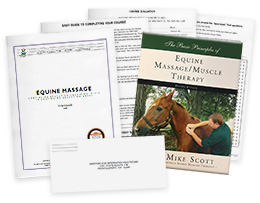
Do you have the Equine Massage/Muscle Therapy textbook? See your enrollment options above for "I already own the text".
Based on a well-illustrated book by Mike Scott, MMTP, this course presents equine A & P; assessment strategies; safety issues for both the horse and the therapist; the theory behind appropriate massage techniques; a discussion of how the author applies techniques in various situations; how he uses stretches to benefit the horse, and how to he uses attention when touching horses. This course provides solid conceptual preparation for seeking hands-on training, but it does not teach hands-on skills. Please seek additional experience, with a mentor, to add hands-on skills.
| Introduction and Commonly Asked Questions | 1 hour |
Muscle Construction and Action
|
1 hour |
| How the Author Manages Common Injuries & Lameness | 0.5 hour |
Anatomy
|
1 hour |
The Author's Massage Techniques
|
1 hour |
The Author's Application of:
|
2 hours |
Stretching
|
1.5 hours |
Saddle Fit Exercises Integrative/Adjunctive Therapies |
1 hour |
| Open-book Test and Course Evaluation | 1 hour |
Thought the written material was very well presented. Love horses! I will now see them with new eyes! I would highly recommend this program!S. Palazzolo, NCTMB
LOVED this course. I am a Human Massage therapist but I also have horses and compete at top levels with them in Barrel Racing. Course was amazing cant wait to help mine and other horses out.S. Gilliland, LMT, NCTMB, ABMP
I loved this course. I have 6 horses and every one of them will benefit from it. I have been interested in equine massage for a while. I would love to incorporate it in my practice.M. Thomas, LMT, NCTMB, ABMP
I plan to take an Equine Massage certification course next month and wanted to have some preliminary information to prepare me for what I will be learning. This course was perfect! The book by Mike Scott is written in an easy-to- understand way that even lay people would understand and be able to use. It was a great introduction to Equine Massage and I plan to purchase the companion DVD, as well as the DVD for advanced techniques, which are both available from Amazon. I am very happy with this course!S.S. LMT in MS
Great Course! I will be using this with my own horse as well as new client horses! It will be a great addition to my horse career!Taylor Chase
I really enjoyed the Equine massage content.Annamaria Maier, LMT
I have horses as well as being a barrel racer. I have many friends who, as myself, believe in chiropractic work on horses as well as massage therapy. I enjoyed this course 100%.Verlynn L. Jones Mallory, NCTMB
I loved learning about Equine Massage. I'm anxious to try it and also learn more about it. Thank you for the information!Susan Collins, LMT, BCTMB
LOVED this course. The author presented his extensive knowledge in a concise and easy to understand manner. I'd love to take an advanced course from the same Therapist, Mike Scott. Thank you so much!Rosemary Barnes, BCTMB
I have been doing Equine Massage and was a student of Linda Tellington Jones and Jack Meagher. Thought this would be very simplified but found it well done and detailed. Thank you!Cathleen Pizzutello, LMT
"Direct Pressure - Once you have determined that deeper pressure is acceptable, and in your evaluation, you have seen a particular restriction, you may want to alleviate it right away by applying direct pressure to the corresponding 'primary active point.'
These are points that receive the most stress and can also correspond to acupuncture or acupressure points. After glancing at the figures, you will see that the major points we will attempt to address are the origin and insertion. However, don't discount the other points that are mapped out, as they can be active as well." (The Basic Principles of Equine Massage/Muscle Therapy by Mike Scott, 2003, p. 2 of Applications)
If you see a restriction during massage and the horse is accepting deeper work, where should you apply direct pressure?


Take our free online course: Ethics Refresher
We will not rent/sell your email to anyone.
You'll also receive our newsletter and special offers.
Thank you! An email will be sent to the address provided with instructions on how to enroll in this 1 CE hour course - FREE!
If you do not see our email within a few minutes of signing up, please check your Spam/Junk folders it may have been delivered there instead of your inbox.
If, by chance, you still have not received it within 5 minutes, please call us at 1-800-364-5722, Monday-Friday, 9am-5pm EST for assistance.